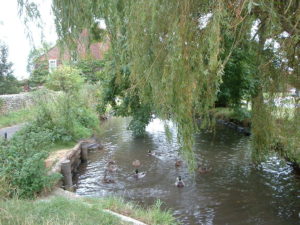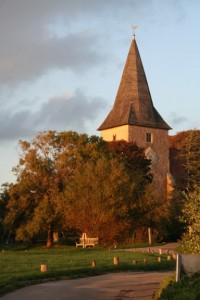I keep wondering whether the Anglo-Saxons or Danes had an interest in Roman history. After all, they must have stumbled across plenty of ruins, and maybe even a surviving building or two. It was gratifying to see the Viking TV show episode where King Ecbert revealed his Roman treasure trove to Athelstan. Why not? I’m sure the moderns aren’t the only people interested in ancient history. So I was very interested to discover that it was thought that King Canute may have erected his Bosham palace on the foundations of Vespasian’s villa, built when the Romans had an encampment there. Vespasian commanded the Second Legion Augusta which is thought to have landed at Bosham in A.D. 44 and saw active service against the Durotriges and the Belgae tribes in southern England.
Here are some items that historians have listed relating to the Roman occupation at Bosham: they know that Chichester Harbor was used as a Roman port (called Magnus Portus). They found a Roman foundation under Trinity Church. In 1800, a colossal head (much eroded) was discovered in a garden; it is thought to have belonged to Emperor Trajan’s statue sited at the entrance to the harbor. A legionary helmet of late-Claudian period was reportedly dredged up in the harbor. Excavations uncovered pottery, midden pits, even wallplaster and opus signinum (Roman waterproof mortar). In the 19th century a roman footbath was discovered in Bull’s Garden, next to Bosham churchyard. In 1832 near Broadbridge house, they discovered the foundations of a building, with walls over 2 feet thick and 6 feet deep with a 6 foot circular bath, an atrium and other rooms, thought to have been used by the troops. Antoninus coins were found embedded in the tile mortar. It is said that archaeologists found the remnants of an ampitheatre, and also a Roman mill-race (possibly the same where Canute’s daughter drowned). And so, the list goes on and on.

Canute’s residence has been customarily called Stone Wall and was probably sited near the harbor. Remnants of a large trough possibly for holding drinking water were discovered nearby. Some think he built his villa on the spot of the old manor house. It seems that the exact location of both Canute’s and Vespasian’s villa are still disputed… and even their very existence. However, local tradition goes a long way, and I say it trumps the experts every time… at least for the Historical Novelist!

Karen says:
I read that Bosham is pronounced something like “bozam?”
My research has mostly dealt with Cornwall and Devon. In Cornwall, the ancient Bochym Manor might have also been sometime pronounced Bozam, and Bosham (although also Bokimpt and Bokinpt,) by the Cornish people living nearby according to an account by a rector of St. Cury Church…there was also in Devon a place called Bozun-Zeal (or Zele.)
I shall have to look at my notes to get the sources.
A Devon knight was once in favor of Henry II and Prince Edward, and his name is now said to be Bauzan. (Although the king’s clerk wrote something translated back to Modern English from the court scribe writing-likely Occitan-French in those days-as Bauchan, and an abbot or his scribe
wrote Bauceyn, and his family held land near a place called Baucombe.)
Also confounding this conglomeration of names is that the banners of the Templars and Hospitaliers were also called by a similar term, as was the bearer of the banner. Sir Bauzan has crossed legs in his effigy, which denoted a crusader. The effigy was ordered built by Edward I Longshanks sometime after Bauzan’s death.
Late to this topic, I know. But all the Bosham/Bozum things herein I find interesting, even if not necessarily related except in sound. I thought a novelist might find it intriguing.
Mercedes Rochelle says:
Well, it is pronounced Bozam; that much is for sure. The rest of your discoveries are most interesting!
David Stephenson says:
BOSHAM!!
Canute’s daughter was buried there …
It appears in the Bayeux Tapestry – in a scene from before 1066.
The remains of what appear to be King Harold II were discovered in the crypt in the church at Bosham in 1955, minus head and a leg (as depicted in the Bayeux Tapestry).
Three purported descendants of Harold attempted to have their DNA compared to DNA taken from the remains … but the Church of England refused to disturb the remains, as they support the Normans.
An attempt through the offices of the Orthodox Church might bear fruits, though, as Harold II was the last Orthodox King of England.
Harold’s son Magnus was buried in Czersk, Poland. His daughter Gytha was buried in St Sophia’s cathedral, Kiev.
Mercedes Rochelle says:
Thanks David! I learned about that on my first visit; I picked up a tiny pamphlet from the church. What a surprise!